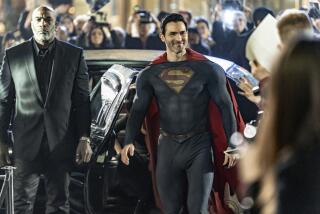Should Public TV Take Off the Gloves? : Television: Often thought of as above the competitive fray, PBS is discovering the value of a solid marketing strategy in its struggle with cable.
Where are all those people who tell you at parties that the only TV they watch is PBS?
Fat chance of finding them.
PBS’ Los Angeles station, KCET Channel 28, draws 3% of prime-time viewers. That’s close to PBS’ national average.
Not much margin for error. And the new pressure for survival is all too clear after PBS’ annual meeting in Dallas last week and KCET’s yearly budget announcement just this Tuesday.
If there’s a message from both sessions, it’s that maybe public television’s slogan ought to be, “Hey, look me over.”
But it’s no joke that PBS’ place in the American scene is being threatened by such cable channels as Arts & Entertainment, Bravo and Discovery, which have moved into the quality programming arena that public television once had to itself.
Cable has hurt ABC, CBS and NBC as an alternative--but it’s a direct challenge to the very existence of important stations like KCET, which almost single-handedly has been an extraordinary civilizing force on television in Los Angeles.
Try to imagine TV here as presented solely by such commercial stations as KABC Channel 7, KNBC Channel 4 and KCBS Channel 2.
A horrifying thought.
So?
So this--from Stephen Kulczycki, station manager of KCET: “We’re in the loyalty business. We like viewers who like our programs so much they’re willing to support them.
“Fundamentally, public television is a belief system that says TV is too important to be left to commercial channels.”
And even the best cultural cable outlets, like A&E;, Bravo and the TNT movie channel, are advertiser-supported.
The survival of the fittest in the ‘90s will come down to who has the greatest lasting power in programming--PBS or cable competitors. Kulczycki, 40, thinks much of cable’s impact derives from its huge financial outlays for the marketing of clever program packages--many of them reruns.
Take the Nick at Nite cable channel, which has done a marvelously creative job packaging such old comedies as “Laugh-In,” “The Donna Reed Show” and “My Three Sons” with contemporary style and wit.
But how many times can you watch the episodes? When will the wit wear out? Will we love these shows in 1995 as we do in 1990? Once they wear out their welcome, how much good, fresh material is there?
And how many times can you sit through “The Grapes of Wrath” and “The Sun Also Rises” on American Movie Classics? It’s a wonderful (and non-commercial) cable channel, and the films are great--until you get to the potboilers and see even them being repeated endlessly.
Then there are cable’s notorious infomercials--those program-length advertisements that feature well-known Hollywood performers helping to hawk everything from cosmetics to music tapes to real estate.
There’s little doubt that PBS would rather go out of business than see its stations run such schlock. Remember the fierce arguments even over PBS’ “enhanced advertising”--which did little more than give program underwriters slightly increased on-air credit?
Again, civility.
But maybe it’s time for PBS to take off the kid gloves in terms of selling itself.
That idea seemed apparent to PBS from reports of last week’s convention. And it also surfaced importantly at KCET’s budget meeting, when station president William Kobin pinpointed a “priority” area:
“Heightening viewer awareness of the unique television . . . services that make KCET so special.”
That’s called marketing, folks. And the fact that the proposal comes from Kobin is significant because he wrote several years ago in the public-television journal, Currents, that PBS faced a dangerous future if it didn’t challenge cable with innovative shows and ideas.
“By the mid-’90s, it’s not impossible that the whole PBS system could go under,” says one public-television executive. “Or a number of cable systems could go under.”
“Public television is a very precarious institution,” Kulczycki says. “Television is changing radically.”
PBS stations in such longtime strongholds as New York, Boston, San Francisco and Minneapolis reportedly are having a tougher time holding audiences. And Kulczycki, who joined KCET seven years ago, acknowledges that although the station’s viewership increased by 300%, there has been a decline from that peak. What happened?
“Cable saturated the Los Angeles market,” he says. “It jumped from 44% of the market in 1988 to 52% last month. The (San Fernando) Valley got cable (in vastly increased numbers). Around the country, as cable penetration increases, public television takes a bounce. You’re paying $30 a month for cable, so you watch.”
And then there are other hassles, like being bumped out of choice viewing spots on a cable dial of 50 or 60 channels, which makes it harder for a station like KCET to be found and thus can cost it potential new subscribers to keep it alive.
At the start of June, for instance, KCET, formerly seen on Century Cable’s Channel 6 in Beverly Hills, suddenly was dropped down to Channel 28 (its UHF number) as a city outlet took over the old high-profile slot.
As Kulczycki says, it’s nice to be cushioned by “Channel 5 on one side and Channel 7 on the other”--in short, being positioned between two heavily watched stations rather than lesser-viewed cable channels.
Risky business.
Nationally, PBS is testing the future by teaming with a prime competitor, The Discovery Channel, to study the possibility of creating a new educational cable service.
Here in Los Angeles, KCET still seems healthy, but the future and its uncertainties are ever-present. Yes, the new $47.8-million budget is bigger than last year’s. And yes, there’ll be more dough to produce national productions for PBS--among other things, they make money for the station.
But there’s little or no extra KCET budget for local productions--just when a newly evolving L.A. should be looking to its most respected TV station for more shows about the changing face of the city. The station has been notable in that area in recent years--from its “Videolog” shorts to its “KCET Journal” documentaries.
For the moment, though, the major problem for KCET--and PBS--is giving themselves a distinctive image, differentiating public television from cable as thoroughly as possible in viewers’ minds, or else there may be no future.
What does KCET do?
“First,” says Kulczycki, “I feel we’re out there in the marketplace every day. You record as much Discovery, Arts & Entertainment, TBS and TNT as you want--and you can’t compare them with us at any point. Second, we’ve got to get stronger to last through the storm.”
Getting stronger, he makes clear, includes promoting KCET’s image--like the fact that it topped all other local stations with 14 Emmys in the most recent awards, though outmanned in staff and equipment.
There are headaches. “By the Year 2000” is an important public-service series to KCET, but, says Kulczycki, “I’m having a hell of a time getting people under 50 to watch it.”
There are upsides: “Our subscription level keeps increasing. There are 352,000 subscribers in Southern California who support us voluntarily.”
Kulczycki thinks L.A.’s huge Latino population can be pivotal to assuring KCET’s stability, and he says it’s “my dream” to have the station introduce a full Spanish-language audio service for stereo TV sets that have two sound channels.
“We know from Nielsen (ratings) data,” he says, “that Latino families are paying attention. For example, the average rating for ‘Sesame Street’ in the Latino community is double that of the general audience. And according to Nielsen, they’re also interested in our ‘Mystery!’ series and our natural history shows.
“About 30% of the people living in the metropolitan Los Angeles area right now are in Spanish-speaking households. And I want to see public television be more relevant to more audiences.”
With just 3% of the prime-time audience, that attitude can’t hurt KCET.
Then there’s cable’s lousy service--a great selling point for any competitor.
And how many times, after all, do you really want to watch “The Grapes of Wrath”?
More to Read
The biggest entertainment stories
Get our big stories about Hollywood, film, television, music, arts, culture and more right in your inbox as soon as they publish.
You may occasionally receive promotional content from the Los Angeles Times.










